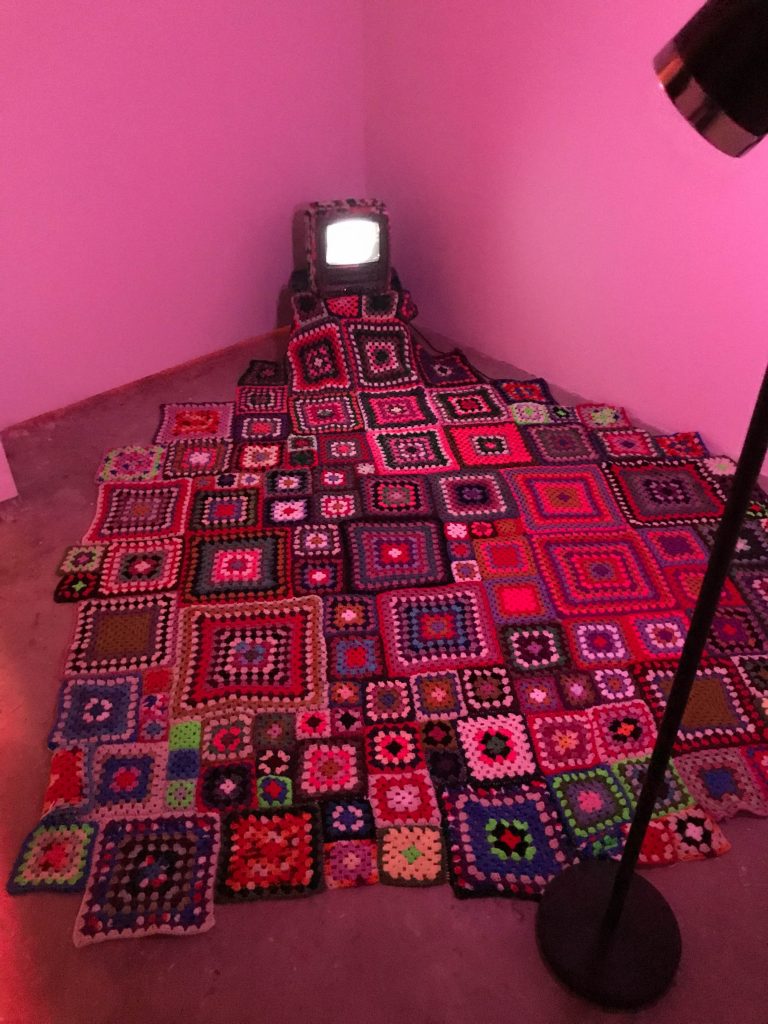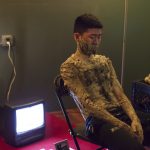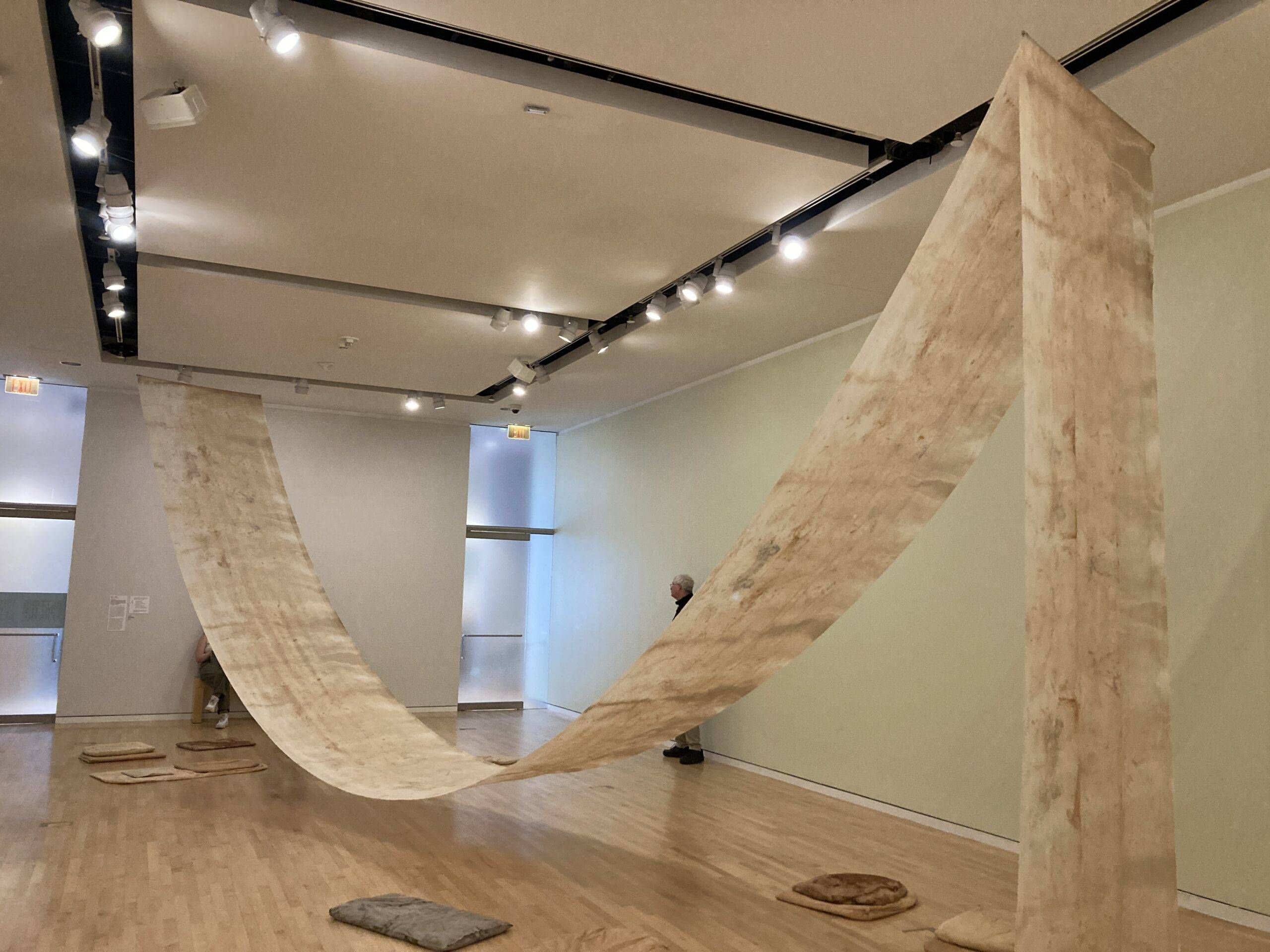The first piece you met upon entering the 2017 Undergraduate Exhibition was a cutout man with a flashing light on his chest and a distorted voice thanking you, over and over, for “being a good art viewer.” This is Untitled (Art Viewer) by Xindi Li (Sculpture, Fall 2018). The flashing light on its chest spelled out “ART VIEWER” too, so that as it thanked its viewers, it likewise labeled itself a viewer.
The piece set a semi-playful, semi-existential tone for the whole exhibition, much of whose work explored the ambiguous space between art, artist, and audience.
Some works questioned this space by inviting viewers into spaces of their own. The installation push me in (who says you can’t go back) by Kelly Mulligan (Art Education, Spring 2019) was situated in a dim little room, lit by a purple floor lamp. In front of a VCR/TV, a crocheted “granny square” blanket invited the viewer to sit, take off their shoes, and watch the TV. The nostalgic elements made it intimate, but the constructed quality gave it a surreal feeling.
Memory Revision, a sound piece by Shelley Ilyssa Davis (FVNMA/Sound, Fall 2018) created a more ambiguous space for the audience to fill with their own interpretations. Sounds of birds, water, wind, wings, footsteps and Yom Kippur prayers flowed from two suspended speakers. The artist invited viewers to write on slips of paper what memories the sounds evoked, and deposit them in a box.
Davis told F Newsmagazine via email that the slips of paper were a way to engage the audience in the work and “ask them to participate in the making of the piece.” The collection of answers, she said, “will eventually be scanned in and become its own archive, just like the [piece’s] collection of sounds and spaces.”
One fascinating self-reflexive piece was Formulation by Anita Chen (ATS/Arts Administration, Spring 2019). It was a mixed media installation with mechanical components, and … somewhat difficult to describe. On the wall hung a large framed square of white papier maché. Four boxes hung haphazardly in front of it, suspended from a motorized ceiling rig. There was a drill bit on the front of each box. As the motor swung the boxes back and forth, the drills bit into the papier maché like pecking robots. The floor below was littered with scraps.
Nearby, a low coffee table entitled Limbo (Magnetic Table No. 1) sat below a window. On closer examination, you discovered that the tabletop was actually hovering, lifted by magnets.
“Whenever people ask me what I’m working on, I try to describe it,” said its designer Dylan Arthur Howard (Sculpture/AIADO, Spring 2019), “but I can’t.” The legs were an angled C, like a trapezoid missing one of its vertical sides. The tabletop, with runners like a pontoon boat, hovered under the top bar of the C legs, attracted upwards to them by twelve small but powerful magnets. The tabletop was restrained to the bottom of the C legs by cables, keeping them perpetually rising towards the legs. The effect was a complexly engineered hoverboard table, absolutely delightful to examine.
The table took Howard eight months, he told F Newsmagazine. He was eager to discuss the ins and outs of his project. It was his first magnet piece, inspired in part by the work of sculptor Bruce Gray. A lot of people he consulted did not think his plan would work; of the functional finished project, Howard says, “It’s nice to know I’m not crazy.”
The magnets, uninstalled, were a terror to live with. They were so powerful that Howard had to plan his steps carefully when carrying them through the house, lest they become attracted to a piece of metal and fly out of his hand.
And how does it feel to be done? “It’s nice,” he said. “Sort of. It’s been on my mind every day for the last eight months.”
At the reception, rapper Limitless Soundz (a Columbia grad student) and sound artist Kush (Fiber/Fashion/ATS 2018) did a collaborative performance in the gallery. Limitless Soundz rapped in a brown cardigan, knit hat, and Locs, while Kush blasted music from a boombox under her Chicago sweatshirt. They performed two songs for a knot of curious onlookers. Dressed like an elementary school’s beloved music teacher, Limitless Soundz sang enthusiastically, clearly enjoying performing, even in front of a small group.
Kush frequently collaborates with Limitless Soundz; she composes the music, he writes the words. Their self-described genre, Pan-African Trap Solution Rap, directly address issues affecting their community: “food deserts, police violence, oppressive systems,” as summarized by Limitless Soundz.
One room of the exhibition was taken up by their collaborative video installation, Limitless Soundz Meets Afro-Samurai. With multimedia and sculptural elements, plus their music, it told the story of a black man on a samurai-style quest for revenge in a racist world.
Asked how it feels to perform in an unusual space like this, Limitless Soundz told FNews that such performances are liberating, precisely because of their different demographic. Here, more than ever, he said, “I still have to be unapologetically myself.”
Kush agreed that in a white-dominated institution, this is harder but more important to do. For her, the songs were an emotional release and a disruption of the racism she experiences here at SAIC. She is from the South Side, and tired of hearing other students say they are “scared” to visit. So, she said, she was bringing the South Side here instead.
This year’s BFA show had enough fascinating pieces to get lost in for hours. There were too many to mention in one article, but a few other memorable pieces included Samuel E. Snodgrass’s (Sculpture/Fashion, Spring 2019) Unidentified Specimens from Voyage 1117, selections from a sci-fi milliner. The style was old fashioned, yet alien, with a vivid color palette. Eunice Choi’s (ATS/AIADO, Fall 2018) Squishy Squashy Wonderland, a tank of colorful silicone sea creatures, was similarly delightful; it invites viewers to plunge their hands in and feel the creatures’ squishy squashy skin.
The 2017 undergraduate show was mounted in the Sullivan Galleries, and closed December 7th.

























